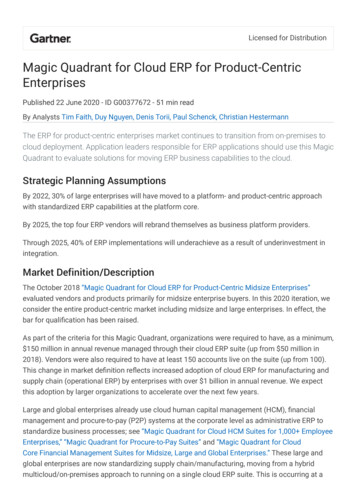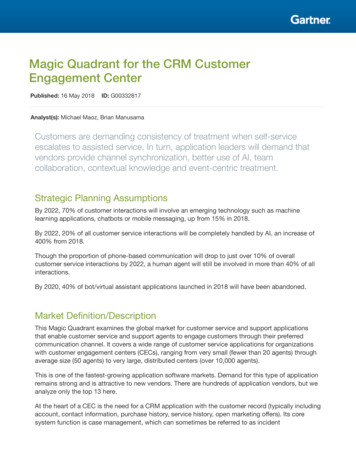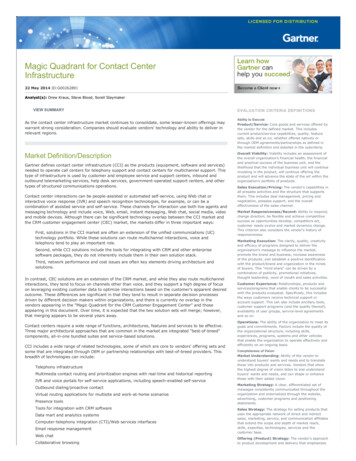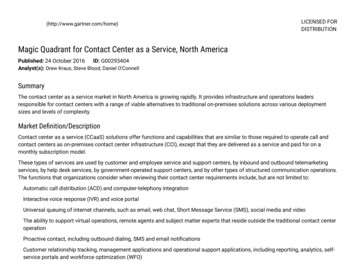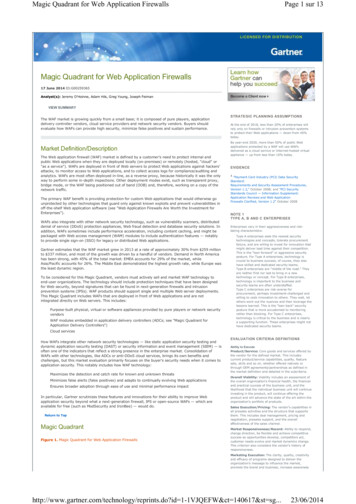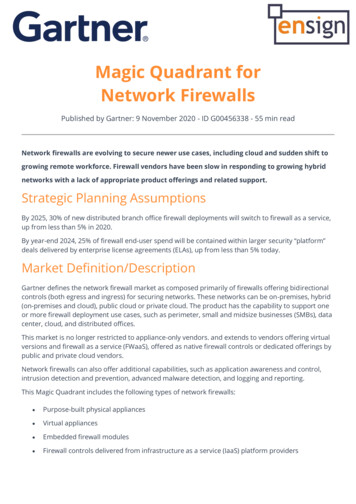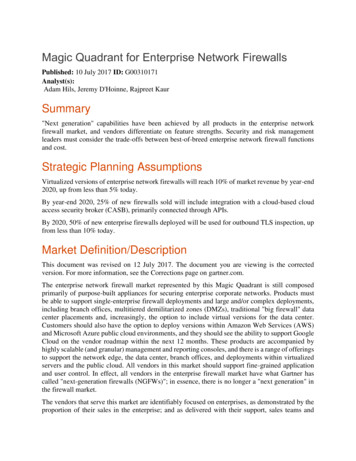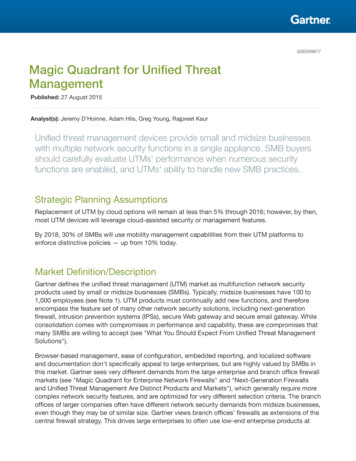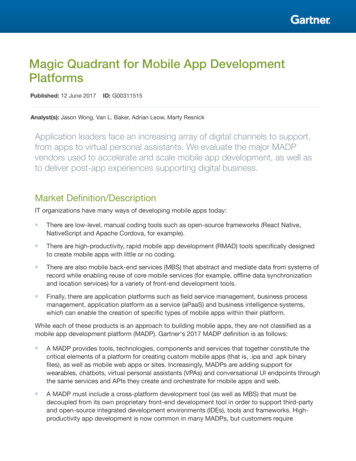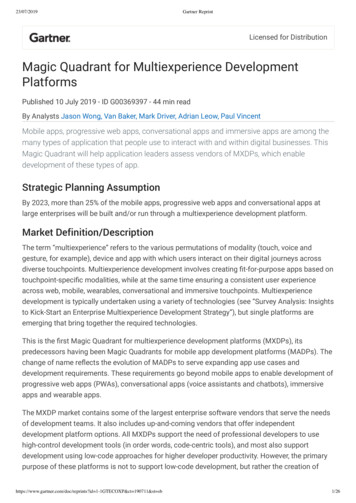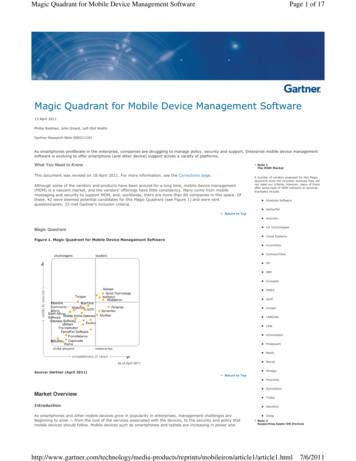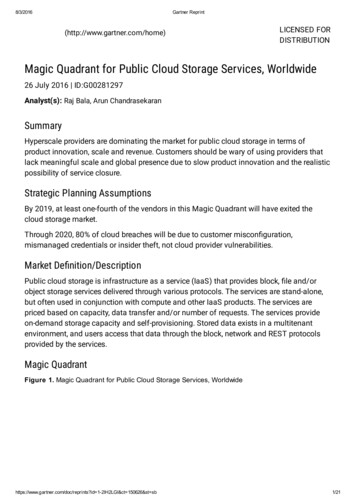
Transcription
8/3/2016Gartner Reprint(http://www.gartner.com/home)LICENSED FORDISTRIBUTIONMagic Quadrant for Public Cloud Storage Services, Worldwide26 July 2016 ID:G00281297Analyst(s): Raj Bala, Arun ChandrasekaranSummaryHyperscale providers are dominating the market for public cloud storage in terms ofproduct innovation, scale and revenue. Customers should be wary of using providers thatlack meaningful scale and global presence due to slow product innovation and the realisticpossibility of service closure.Strategic Planning AssumptionsBy 2019, at least one-fourth of the vendors in this Magic Quadrant will have exited thecloud storage market.Through 2020, 80% of cloud breaches will be due to customer misconfiguration,mismanaged credentials or insider theft, not cloud provider vulnerabilities.Market Definition/DescriptionPublic cloud storage is infrastructure as a service (IaaS) that provides block, file and/orobject storage services delivered through various protocols. The services are stand-alone,but often used in conjunction with compute and other IaaS products. The services arepriced based on capacity, data transfer and/or number of requests. The services provideon-demand storage capacity and self-provisioning. Stored data exists in a multitenantenvironment, and users access that data through the block, network and REST protocolsprovided by the services.Magic QuadrantFigure 1. Magic Quadrant for Public Cloud Storage Services, Worldwidehttps://www.gartner.com/doc/reprints?id 1-2IH2LGI&ct 150626&st sb1/21
8/3/2016Gartner ReprintSource: Gartner (July 2016)Vendor Strengths and CautionsAlibabaLocations: Asia/Pacific (Mainland China, Hong Kong, Singapore) and North America (U.S.)Key storage services: Block storage, Object Storage Service, file storage (limited preview)Alibaba is the largest digital commerce company in the world by revenue. Alibaba has beenoffering the Aliyun cloud service since 2011, with an initial focus on customers in China. In2015, Alibaba expanded its cloud services presence by opening up new regions inSingapore and the U.S. It also announced a partnership with Meraas, a Dubai-basedholding company, to expand into the Middle East.Alibaba has introduced several new features in 2015, such as cross-region replication, solidstate drive (SSD)-backed volumes and virtual private cloud (VPC) support to keep its cloudservice competitive relative to its peers. In addition to the storage services, Alibaba alsohttps://www.gartner.com/doc/reprints?id 1-2IH2LGI&ct 150626&st sb2/21
8/3/2016Gartner Reprintoffers compute, content delivery network (CDN) and database services, as well as valueadded packaged services such as multimedia transcoding and image processing. Themajority of existing customers are Chinese technology companies that are looking for alow-cost IaaS platform for hosting their web applications.STRENGTHSAlthough a late entrant, Alibaba has committed large financial resources to its clouddivision that have resulted in a regular cadence of new products and functionalities andexpansion into newer geographies.Aliyun's storage pricing is simple and competitive, thanks to the huge scale of its ecommerce operations. It has initiated several price reductions in the past 12 months to itsstorage and network egress pricing.Unlike other cloud providers, Alibaba doesn't charge separately for phone support andbundles it as part of the base service.CAUTIONSAlibaba has a limited track record and mind share as a cloud provider among enterpriseIT outside of China.Most of Alibaba's independent software vendor (ISV) and channel partners are localChinese companies that have no presence outside China.Alibaba's storage services API has limited compatibility with the popular backup/recoveryand archiving ISVs. In addition, it has limited support with cloud storage gatewayvendors; instead, Alibaba promotes a cloud storage gateway from DT Dream, a companythat it has invested in.Amazon Web ServicesLocations: North America (U.S.), South America (Brazil), EMEA (Ireland, Germany),Asia/Pacific (Australia, China, India, Japan, Singapore, South Korea)Key storage services: Amazon Elastic Block Store (EBS; block storage), Amazon ElasticFile System (EFS; file storage currently in preview), Amazon Glacier (archival objectstorage), Amazon Simple Storage Service (S3; multiple tiers of object storage)Amazon Web Services (AWS) dominates the IaaS market and has the most comprehensivestorage offerings. Amazon S3 is 1.6 times as large as all the other object storage servicesin this Magic Quadrant combined, as measured by amount of data stored. AWS' storageofferings include various tiers of block and object storage services that span performanceand durability across commensurate price tiers. AWS also offers its Elastic File System(EFS), a managed service with support for Network File System (NFS). This givescustomers the ability to "lift and shift" applications to public cloud IaaS environments, but itis expensive relative to its other storage services. AWS has more insight than any othervendor on how customers use public cloud storage services at scale. This deep knowledgeof customer usage and AWS' ability to both react to and build solutions ahead of themarket forms the basis for its overall competitive strength. AWS customers benefit by usinghttps://www.gartner.com/doc/reprints?id 1-2IH2LGI&ct 150626&st sb3/21
8/3/2016Gartner Reprinta vendor that is often the first to offer new category-defining features and services. Thiswas recently evidenced by AWS being the first to offer premium block and file storage onSSD (EBS provisioned IOPS [PIOPS], EFS), cold tiers of block and object storage (EBSMagnetic, Glacier) and an event-driven microplatform as a service (PaaS, AWS Lambda)that is well-integrated to its storage services.STRENGTHSThe scale at which AWS operates its public cloud storage services dwarfs the othervendors in this Magic Quadrant. This results in customers using a provider with clearoperational abilities, even if it isn't the least expensive option.AWS has the most extensive public cloud storage services, including block, file and objectinterfaces designed to match a wide variety of workloads ranging from low-cost, lowerperformance to higher-cost, higher-performance and options in between.AWS's storage services are well-integrated with each other and its other services such asLambda, Amazon Elastic Compute Cloud (EC2), Amazon Elastic MapReduce (EMR), AWSKey Management Service (KMS) and AWS Import/Export Snowball, delivering compellingsolutions spanning compute, storage, networking and security.CAUTIONSRetrieving a large amount of data from Amazon Glacier within a short window of timecan result in high retrieval fees, but staging this request over time to avoid such highretrieval fees is exceedingly difficult and leads to much higher recovery time objective(RTO). Exporting data using Snowball results in high bandwidth charges even though nopublic network is used.Pricing for various AWS storage services is complicated and thus difficult to understandand predict, particularly when request charges, IOPS, data transfer and throughput needto be considered to appropriately match workload characteristics to infrastructure.Organizations can experience improved agility by using AWS, but this should betempered with the fact that customers frequently overprovision compute and blockstorage resources that are not fully utilized, often negating the benefits of agility byincreasing costs. AWS needs to improve its capabilities to help customers consumeservices more efficiently when using its platform.AT&TLocations: North America (U.S.), EMEA (U.K., the Netherlands)Key storage services: Cloud Storage (object storage)AT&T markets an object storage service based on storage products from EMC. Much ofAT&T's Cloud Storage service is based on EMC Atmos. New users of AT&T's Cloud Storageconsume storage on a service based on EMC's Elastic Cloud Storage (ECS) product, thesuccessor to Atmos. AT&T supports both the Atmos and Amazon S3 APIs, but in limitedform. AT&T's customers use commercial applications from vendors such as Commvault forenterprise backup and Syncplicity for enterprise file synchronization and sharing (EFSS).https://www.gartner.com/doc/reprints?id 1-2IH2LGI&ct 150626&st sb4/21
8/3/2016Gartner ReprintUsers can add metadata to objects that can trigger policies to control whether objects areprotected locally or replicated across sites for a higher price per GB. AT&T's Cloud Storageservice is currently available as a self-provisioned service in multiple data centers in theU.S. and Western Europe.STRENGTHSAT&T has broad experience working with large-enterprise and U.S. governmentcustomers.AT&T provides extensive networking functionality for its customers and for enterpriseswilling to leverage its Multiprotocol Label Switching (MPLS) network or 3G/4Ginfrastructure.AT&T will negotiate terms with customers rather than enforcing standard click-throughagreements presented to the user during the course of account creation and serviceprovisioning.CAUTIONSAT&T recently shut down its public cloud compute offering. AT&T's dependency on EMCand the dominance of the hyperscale vendors such as AWS and Microsoft create adifficult environment for a vendor with a single, undifferentiated, general-purpose cloudstorage service.AT&T neither develops nor operates its cloud storage service by itself. AT&T relies onEMC for storage software and hardware while relying on EMC's Virtustream business unitfor the ongoing operation of the service.AT&T operates no identity and access management (IAM) services to secure its cloudstorage service. Users are unable to grant or deny granular access to data by operation(list, read, create, delete, modify, and so on) and thus require granting wide-rangingpermissions. AT&T Cloud Storage does not provide short-lived tokens, which results inapplications needing hard-coded account credentials. Granting wide-ranging permissionsand hard-coded account credentials in an application creates a risk that can lead toexposure.GoogleLocations: North America (two in the U.S.), EMEA (Belgium), Asia/Pacific (Taiwan)Key storage services: Google Cloud Storage (object storage), persistent disk storage (blockstorage), Google Cloud Storage Nearline (archival object storage)Google was a late entrant to the cloud storage market segment in 2010, although it hasbeen a SaaS provider to small and midsize businesses for close to a decade. Google CloudPlatform's storage services consist of object storage (available as standard and durablereduced availability tiers), persistent disk storage (block) and a long-term retention storagetier (Nearline). The object storage service is available as standard and reduced services thatare differentiated by availability and performance rather than data durability. Google hasexpanded its workload focus across six key vertical industries in the past year — media andhttps://www.gartner.com/doc/reprints?id 1-2IH2LGI&ct 150626&st sb5/21
8/3/2016Gartner Reprintentertainment, life sciences, retail, financial services, gaming and technology companies.Google emphasizes its technology leadership in building distributed systems, its globalnetwork, a strong commitment to open source, and low costs as key differentiators tocustomers.STRENGTHSGoogle has exceptional software engineering, large-scale infrastructure operationexperience and a large financial war chest. These elements, along with a strong desire tobe a viable public cloud contender, can make it a formidable competitor over time.Google delivers compelling price/performance across its block and object storage tiersdue to its software-defined networking (SDN) investments, strategically placed edgelocations and low price per IOPS for its SSD-based block storage tier.Google's data products such as BigQuery and Dataproc are highly scalable and wellintegrated with its cloud storage services, and can enable a wide variety of batch andstreaming analytical use cases.CAUTIONSRevenue from selling enterprise-focused IT products is secondary to Google's advertisingbusiness, and, as a result, Google lacks a compelling enterprise strategy because itcurrently does not have the sales, marketing, globalization, and partner ecosystem tomake it broadly attractive as a strategic enterprise cloud IaaS provider.Google storage is available in just four geographies (only two outside the U.S.), whichmay not meet the data residency requirements of many non-U.S. customers. Moreover,Google's data centers outside the U.S. aren't located in major countries with a largedemand for cloud storage.The ecosystem of ISV partners available in Google Cloud Launcher (marketplace) as wellas certified ISVs are quite minimal when compared to its larger competitors, which limitspotential use cases and makes "try and buy" decisions difficult.IBM (SoftLayer)Locations: North America (U.S., Canada, Mexico), South America (Brazil), EMEA (France,Germany, Italy, U.K., the Netherlands), Asia/Pacific (Australia, Hong Kong, India, Japan andSingapore)Key storage services: Object storage, file storage, block storageAfter the SoftLayer acquisition in 2013, IBM retired its SmartCloud Enterprise offering andhas focused on expanding the cloud service portfolio, partner ecosystem and geographicreach of SoftLayer. SoftLayer offers block, file and object storage services on an ondemand basis. SoftLayer offers both basic and performance-oriented block and file storagetiers, which can be used in conjunction with its hosting and cloud IaaS offerings. The blockstorage service is internet Small Computer System (iSCSI)-based with integrated snapshotsand replication, while the file service is Network File System (NFS)-based with similar dataprotection capabilities. SoftLayer's object storage service is underpinned by OpenStackhttps://www.gartner.com/doc/reprints?id 1-2IH2LGI&ct 150626&st sb6/21
8/3/2016Gartner ReprintSwift. In addition to the services rated in this Magic Quadrant, there are related noncloudservices; SoftLayer offers dedicated QuantaStor appliances for block and file storagethrough a partnership with OS Nexus, and IBM has also begun to offer dedicated andmultitenant virtual storage appliances hosted in SoftLayer, using products like SpectrumAccelerate (formerly XIV) and Spectrum Scale (formerly GPFS). SoftLayer has made stronginvestments in data centers across the globe in more than 15 regions, and providestechnical support and documentation in more than eight languages.STRENGTHSSoftLayer provides flexibility and choice to customers through its dedicated andmultitenant storage services that can be integrated with its bare-metal servers, virtualservers, and hosted appliances to enable diverse use cases.SoftLayer's storage services are increasingly marketed and sold through the global saleschannel of IBM and its partners, and IBM is increasingly hosting storage solutions inSoftLayer data centers.Since the acquisition by IBM, SoftLayer has significantly expanded its global reach, withmore than 15 data centers outside North America across key locations in Europe, SouthAmerica and Asia/Pacific.CAUTIONSSoftLayer is one element of IBM's cloud storage portfolio, which is complex andundifferentiated. It has too many overlapping products, which causes confusion amongcustomers. There are significant concerns regarding the long-term viability of SoftLayer'sOpenStack Swift-based object storage offering that will be replaced by the new IBMCloud Object Storage, which is based on the Cleversafe dsNet product. The new service isstill being integrated into the rest of IBM's cloud platform.Although it has been three years since the acquisition of SoftLayer, the adoption of itscloud storage services is still largely relegated to gaming and consumer-focusedtechnology companies. The adoption among enterprise customers continues to be lowdue to product weaknesses and lack of focus.SoftLayer's object storage service doesn't support cross-region replication and relies oncustomer-initiated writes instead, placing the burden of data protection on the user ratherthan the platform.MicrosoftLocations: North America (U.S. and Canada), South America (Brazil), EMEA (NorthernEurope), Asia/Pacific (Hong Kong, China, Singapore, Australia, Japan, India)Key storage services: Object Storage (standard and archive blob storage), File Storage,Block Storage (standard and premium)Microsoft is currently the most prominent competitor to AWS from the perspective ofenterprise adoption. Most enterprise customers that are considering Microsoft Azure alsoevaluate AWS — even for workloads based on Windows. When customers choose Microsofthttps://www.gartner.com/doc/reprints?id 1-2IH2LGI&ct 150626&st sb7/21
8/3/2016Gartner ReprintAzure, their existing relationships with Microsoft and/or their channel partner play animportant role. The Microsoft Azure storage offerings feature block, file and object storageservices that address a wide range of workloads, but they are mostly behind AWS's servicecapabilities, adoption and mind share. Microsoft's Azure File Storage service, currently theonly public cloud-based managed service that supports server message block (SMB), is awidely used storage protocol that allows applications to be "lifted and shifted" to Azure.Customer references who use both Azure and AWS indicated that Microsoft possesses ahigher degree of involvement in the customers' application architecture, business objectivesand support issues among local Microsoft personnel compared to AWS. This results in aconsultative approach by Microsoft to building and deploying applications using Azure'sservices.STRENGTHSMicrosoft has a strong enterprise focus, a solid understanding of enterprises' needs, andthe resources in place globally to serve them well.Microsoft has been making a concerted, public effort to support non-Microsofttechnologies, including Linux and iOS, using Azure's services, giving customers a widerarray of choices than those just limited to Windows operating systems.Application developers who use tools such as Microsoft Visual Studio and .NET will finda well-integrated experience from the perspective of developing and building to deployingand running applications on Azure.CAUTIONSMicrosoft is an innovation laggard, trailing behind AWS in both breadth and depth ofpublic cloud storage service offerings. This is most evident in limited classes of blockand object storage services, but extends to management aspects such as life cyclepolicies for objects and IAM policy integration.Porting an application to use Microsoft Azure's Blob storage service will requiresignificant investment in an API whose adoption is a fraction of that of Amazon S3.Microsoft claims a large number of regions where Azure is available, but not all storageservices are available in each region.OracleLocations: North America (U.S.), EMEA (U.K., the Netherlands)Key storage services: Object storage, block storageOracle's first foray into the IaaS market was a general-purpose object storage service, but ithas since expanded to also include a low-cost, tape-based object storage service focusedon archival use cases. Oracle Cloud offers block storage for use with compute workloadssuch as databases and object storage services for unstructured data in two tiers: diskbased object storage and tape-based archival object storage. Oracle offers iSCSI to connectwith block storage volumes and the OpenStack Swift protocol for use with its objectstorage services. Oracle Cloud's compatibility with OpenStack Swift employs proprietaryhttps://www.gartner.com/doc/reprints?id 1-2IH2LGI&ct 150626&st sb8/21
8/3/2016Gartner Reprintextensions to support unique aspects of its archive service offering, such as the ability torequest that data be fetched from tape-based archival storage. Oracle Cloud also supportsthe Amazon S3 protocol, but this is currently only available to third-party integrationpartners.STRENGTHSOracle's deep knowledge of its ow
Magic Quadrant for Public Cloud Storage Services, Worldwide 26 July 2016 ID:G00281297 Analyst(s): Raj Bala, Arun Chandrasekaran Summary Hyperscale providers are dominating the market for public cloud storage in terms of product innovation, scale and revenue. Customers should be wary of using providers that

